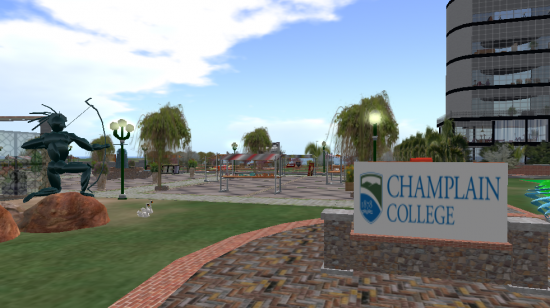In November, I led a well-attended three-hour workshop, Second Life is Dead – Prepare for an OpenSim Future at the 17th International Conference on Online Learning in Orlando, Florida.
My basic point was that, right now, Second Life as a product for educators is actually dead unless something dramatically changes with the strategy of Linden Labs — which always remains unclear. With the increasing stability of OpenSim and the proliferation of grids, there is no real reason to pay a dime to Linden Labs for a virtual world experience.
But I also learned a few things as a result of the conference, including the fact that schools are just not ready or equipped to run OpenSim themselves. Fortunately, there are alternatives, in the form of third-party hosting providers.

The Second Life exodus
Schools and colleges have stopped renewing their Second Life projects. My last region, for example, will be gone in June.
School cannot — and should not have to — pay the prices that Linden Lab charges. Plus, educators can still use Second Life — if needed — without renting land themselves. As a result, regions are being dropped as the expiration dates arrive.
The transition can cause some distress but, in the end, moving to OpenSim better serves the goal of using virtual worlds for education.
In any case, Second Life was always dead as far as K-12 schools are concerned, because of age restrictions and other issues. Second Life is not the appropriate setting for these age groups. But it is in this area that the use of virtual worlds can have the most impact.
Some schools looked at Second Life as a marketing ploy for enrollments. It only remotely served as a “me too†environment, but, as even many companies have observed, it is not an appropriate marketing tool for enrollments or sales. And, regardless of what many may believe, Second Life does not have a good connotation as a product.
Even when schools do use their Second Life regions, they regions are only busy about 10 percent of the time –Â the rest of the time the workspaces are idle. It is usually not an entire school that is embracing the technology, but merely a few scattered individuals within the school.
Hosting OpenSim is hard
Sure, I have 37 years of IT technical experience. Hosting OpenSim falls on the light side of expertise required — for me, at least.
But after talking about the simple basics of IP addresses, ports, port forwarding, all attendees were lost.
If someone does not understand even the most basic concepts of networking, then hosting a grid on your own is probably not recommened.
So my advice now: Skip it, host somewhere else.
Schools — especially K-12 schools — Â probably should not take on hosting on their own.
For the most part, technology departments do not allow educators to run their own servers with the necessary ports open to make it work. And it is not really something to expect an IT department to host, and, in any case, individuals educators probably do not have the time or expertise to perform all the technology management tasks surrounding any server environment.
Making virtual education work takes planning and good design
College kids find it cartoonish, but will still work effectively in a well-designed environment. Before the specific learning experience, most would have never used Second Life or OpenSim.
Though many educators have created great learning environments, there is still the persistence of using it as a mechanism for presentations using Power Point and similar tools. This is ineffective use of the capabilities of using virtual worlds for education.
Meanwhile, creating effective learning environments in virtual environments is is labor intensive. The learning curve is steep for both the user and the educator.
That is also true when it comes to mesh. Too many are caught up with the idea of mesh, and do not understand that it takes a great deal of expertise to use tools like Maya to create quality 3D objects. Plus, not all current viewers can see or use mesh objects. Yes, mesh is  the foundation of most top-rated video games on the market, but the artists that create those games are highly skilled and talented.
Some educators said they were interested in being a part of my consortium — the OSGrid Educational Collaborative — but I am currently near capacity. I can take on three more, and that will be it for now.
Bottom line
Educators are interested in OpenSim, but most have never seen it, and many have no clue what it is.
Using 3D virtual environments and simulations will be the future in education. Will it be OpenSim? This is anyone’s guess.
- Prof: Schools moving to OpenSim should pay for hosting - January 2, 2012
- It’s time to move all grids south - September 11, 2011
- Five steps to OpenSim at your school - August 17, 2011
